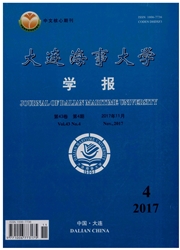

 中文摘要:
中文摘要:
为推进一带一路的建设与沿线国家的贸易往来,运用社会网络分析法对一带一路沿线国家的海运联系进行研究.首先,从出度和入度两个角度对42个国家建立网络模型,分析国家间的复杂关系;其次,对网络进行中心性分析,判断国家的海运辐射范围,基于核心—边缘理论对一带一路沿线国家进行划分;最后,利用Concor算法对国家海运网络进行社团结构分析,利用K-plex算法进行凝聚子群分析.结果表明:一带一路沿线国家之间存在密切的海运联系,核心国家与边缘国家圈层明显,同时产生了三个结构较为成熟稳定的子群;东盟国家和西亚国家在一带一路内扮演着重要角色,推动国家之间的海运往来,促进区域海运的繁荣发展.
 英文摘要:
英文摘要:
This paper focuses on the study of maritime relations of countries along One Belt and One Road( OBOR) by using social network analysis to promote OBOR construction and trade flow. Firstly,a network model with OBOR of 42 countries was established to analyze the complex relationship among countries from aspects of out-degree and in-degree.Secondly,network centrality was analyzed to determine the radiation scope of national maritime,and the countries along OBOR was classified based on core-periphery theory. Finally,the community structure of OBOR was analyzed by using Concor algorithm,and the K-plex algorithm for cohesive subgroup analysis. Results show that the close relationship exists among countries along OBOR. And it is obvious that there is the difference between the core country agglomeration and the edge of the country agglomeration. The countries of ASEAN and West Asian plays a leading role in driving national maritime network connectivity and promoting the prosperity of the regional maritime development.
 同期刊论文项目
同期刊论文项目
 同项目期刊论文
同项目期刊论文
 Competition with online and offline demands considering logistics costs based on the hotelling model
Competition with online and offline demands considering logistics costs based on the hotelling model An immune co-evolutionary algorithm based approach for problems related to clothing uniform assignme
An immune co-evolutionary algorithm based approach for problems related to clothing uniform assignme 期刊信息
期刊信息
